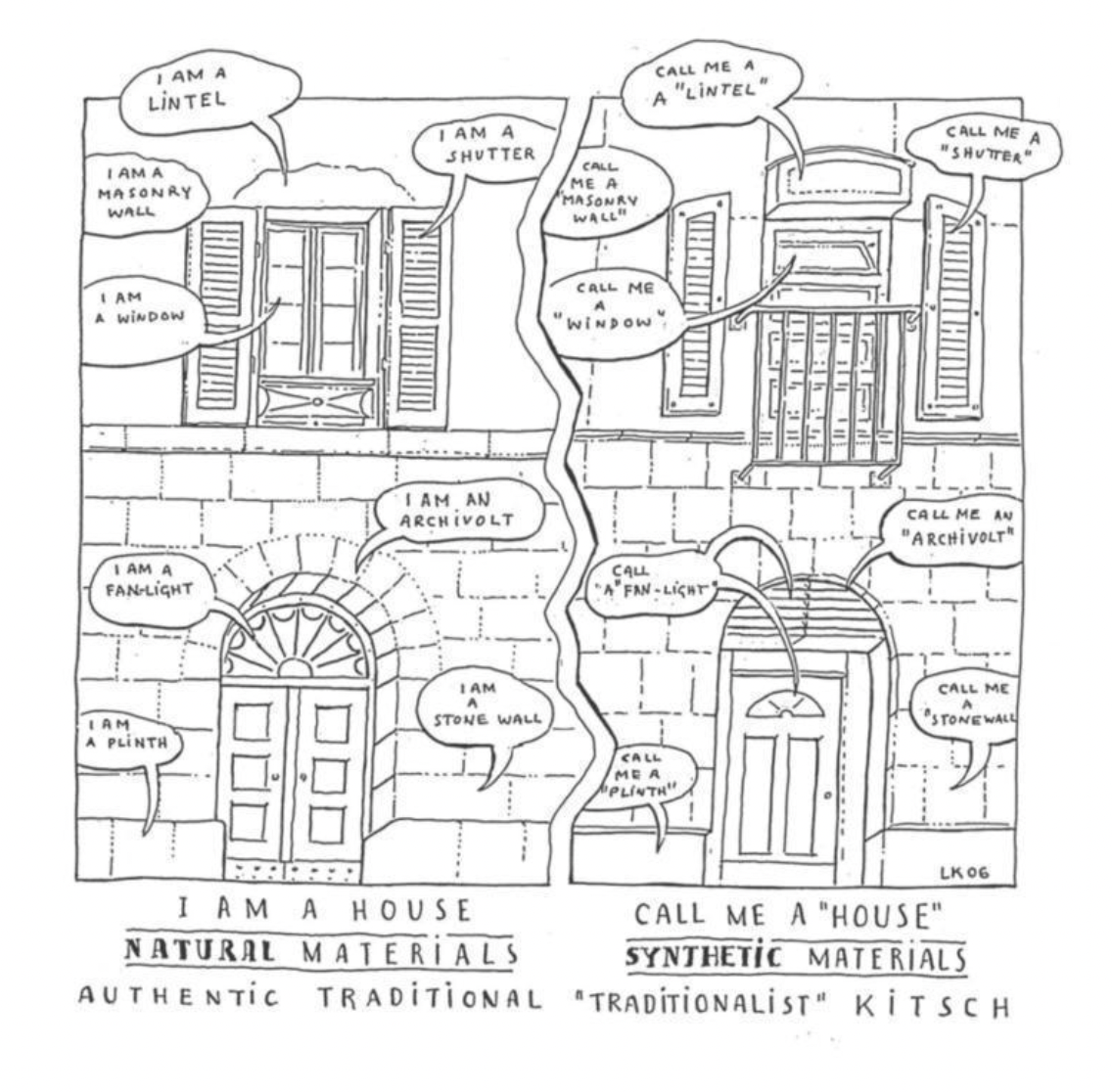Leon Krier, a prominent figure in urban planning and architecture, has been a key voice in the dialogue around traditional architecture and urbanism. His ideas, outlined in various essays and books, present a critical perspective on the current architectural landscape, particularly regarding the distinction between authentic traditional architecture and what he terms “traditionalist kitsch.” To Krier, authentic traditional architecture embodies cultural continuity, craftsmanship, and contextual integrity, while traditionalist kitsch, in contrast, reflects superficiality, commodification, and a loss of genuine connection to tradition.
Authentic Traditional Architecture: Cultural Continuity and Craftsmanship
At the core of authentic traditional architecture, according to Krier, is a profound respect for cultural heritage and historical continuity. Traditional architecture, as he defines it, isn’t simply about aesthetic choices but rather embodies deeper cultural values that have evolved over generations. This style relies on time-tested techniques, local materials, and forms that are harmonized with the landscape and social context of their surroundings. It reflects a commitment to quality and craftsmanship, with each element carefully considered for its function, symbolism, and durability.
For Krier, traditional architecture is a product of organic growth rather than an imposed style. It grows out of specific cultural, climatic, and geographic conditions, making it unique to a place and time. Authentic traditional buildings serve as tangible expressions of human history and civilization, creating a sense of belonging and identity. Krier argues that by preserving and building upon these forms, societies can maintain continuity with their cultural past, which he sees as crucial for the psychological and social well-being of communities. Traditional structures not only shelter but also instill a sense of pride, meaning, and stability, fostering a collective memory and shared identity among residents.
Krier’s work also emphasizes that authentic traditional architecture naturally evolves while retaining its core principles. In his view, modern materials or technologies can be incorporated into traditional forms as long as they respect the existing aesthetic, scale, and proportion. This adaptation ensures the architecture remains functional and relevant while preserving the intangible qualities that define traditional aesthetics.
Traditionalist Kitsch: A Superficial and Commodified Approach
In contrast to authentic traditional architecture, Krier views “traditionalist kitsch” as a form of architectural mimicry that sacrifices genuine cultural value for the sake of appearance. Traditionalist kitsch, to Krier, lacks the cultural and historical grounding of authentic traditional architecture, drawing instead on superficial stylistic elements. While it may appear “traditional” at a glance, this type of architecture is usually an ahistorical pastiche of ornamental motifs that fail to engage with their context or embody the craftsmanship found in genuine traditional buildings.
Krier sees traditionalist kitsch as a response to consumer demand rather than an authentic expression of culture. Often, these buildings employ historical-looking facades to create an illusion of authenticity without the craftsmanship, proportionality, and integrity that define traditional architecture. This process results in a disjointed architectural environment where buildings lack depth and coherence, designed to evoke nostalgia rather than to connect with historical continuity in any meaningful way.
According to Krier, traditionalist kitsch is prevalent in commercial and residential developments that use “traditional” architectural features solely as decorative elements. For instance, neo-Tudor houses or “colonial” townhouses might feature ornamental gables or false dormers that evoke a particular historical style but are ultimately hollow and meaningless. These elements are often produced using mass-manufactured materials and applied to standard building structures without consideration for their original context or structural function, reducing traditional forms to a series of empty visual cues.
The Role of Mass Production and Market Forces
Krier attributes much of the rise of traditionalist kitsch to the influence of modern construction methods and market forces that prioritize cost-efficiency and speed over quality and integrity. Mass production has enabled the replication of “traditional” styles on a large scale, allowing developers to cheaply produce buildings that mimic historical styles without embodying the principles that make them authentic. Traditionalist kitsch, in Krier’s view, is thus a product of a consumer society that values the aesthetics of tradition but lacks a genuine connection to it.
In modern capitalist societies, there is a demand for houses, neighborhoods, and commercial districts that “look traditional” but are quick to build and easy to sell. Traditionalist kitsch, therefore, is often a compromise, delivering the appearance of tradition without the substance. Krier argues that the resulting architecture is fundamentally dishonest, offering a kind of visual comfort while contributing to a soulless, disoriented urban landscape. This superficial approach, he contends, ultimately erodes the cultural and aesthetic integrity of cities.
Krier’s Vision for Reviving Traditional Urbanism
Krier advocates for a return to authentic traditional architecture through a revival of traditional urbanism, where communities are planned with consideration for scale, proportion, and human interaction. He champions the idea of creating walkable, mixed-use neighborhoods that prioritize public space, community interaction, and architectural coherence. His urban planning proposals emphasize the importance of human-scale development, where buildings are crafted with the same attention to detail as those of historical city centers.
To counter the spread of traditionalist kitsch, Krier calls for architects, planners, and developers to approach design with an understanding of traditional principles rather than simply copying stylistic elements. He believes that by educating architects in the skills and principles of traditional building methods, it is possible to create buildings that are both modern and grounded in cultural heritage. For Krier, the key is not to return to the past but to use traditional principles as a foundation for contemporary design that respects and builds upon history rather than commodifying it.
The Ethical Dimension: Architecture and Society
Krier’s critique of traditionalist kitsch is also rooted in an ethical perspective on architecture’s role in society. He argues that buildings and urban spaces shape not only our physical environment but also our values and social relationships. When architecture becomes a vehicle for superficial aesthetics, it loses its potential to foster meaningful connections between people and their environment. Traditionalist kitsch, in Krier’s view, fails to provide the same sense of place and permanence that authentic traditional architecture offers.
In contrast, authentic traditional architecture, through its adherence to cultural continuity and human-centered design, promotes a stable and enriching environment for people to live, work, and interact. Krier envisions an architectural practice that takes responsibility for the social and cultural impacts of design choices, creating spaces that enhance the lives of individuals and communities rather than merely serving economic interests. By preserving and adapting traditional forms, he argues, architects and planners can contribute to a more harmonious and sustainable built environment.
Conclusion: Beyond Aesthetics to Principles
Leon Krier’s distinction between authentic traditional architecture and traditionalist kitsch ultimately underscores a broader critique of contemporary architectural practices that prioritize form over substance. For Krier, authentic traditional architecture embodies values of craftsmanship, historical continuity, and respect for human scale, whereas traditionalist kitsch represents a commodified, shallow approach that sacrifices these principles for superficial appeal. By advocating for a return to genuine traditional principles, Krier encourages architects to see beyond mere aesthetics, recognizing that architecture has a profound impact on society and culture. In his vision, a revival of authentic traditional architecture offers a pathway toward building communities that are not only beautiful but also meaningful and enduring.




0 Comments